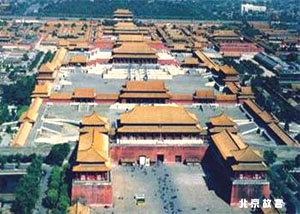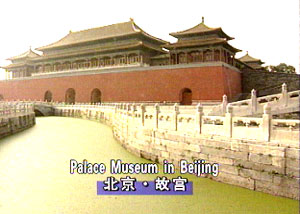 |
|
| Palace Museum |
| CCTV.COM 2002-05-21 14:05:34 |
|
 Nearly all palaces have been reduced to rubbles in wars, but the last imperial palace group built in China in the 15th century has survived. Today it is called the Palace Museum. Nearly all palaces have been reduced to rubbles in wars, but the last imperial palace group built in China in the 15th century has survived. Today it is called the Palace Museum.
Formerly the Palace Museum at the centre of Beijing was called the Forbidden City. It is surrounded by the imperial town, the inner and the outer city walls. Looking down from above, the palace complex is at the centre of several concentric squares. Around the 4-square-kilometre castle lies a wide artificial moat. All these make the palace complex awe-inspiring and mystic. Not like the palaces in other countries, Chinese palaces emphasise the absolute imperial power through complicated ritual rules and spatial and temporal variations during the procedures that start from the south end, the South-Facing Gate. The vassals and subjects went through the long "heavenly street," the Heavenly Peace Gate or Tian'anmen, the Gate of Correct Demeanour, the Meridian Gate and the Hall of Supreme Harmony and finally entered the court. On the gate planks of the five gates there were nine rows of door-nails. Those door-nails, like other ornament in the palace complex, symbolised the supreme imperial power, because ancient Chinese believed nine and five were numbers of supremacy. Here ancient ideology and ancient buildings have become one.
The Meridian Gate is a U-form building. The square in front of the Gate can hold twenty thousand people. During the dynasties from the 15th to the 19th centuries, this was the place where emperors held national ceremonies, but in most cases, it was the place for the cabinet ministers to gratefully hear imperial edicts on knees.
The Gate of Supreme Harmony is the first gate after the entrance of the Palace Museum. From this gate one can see the Hall of Supreme Harmony on an eight-metre marble base. The palace was a symbol of the sovereign's absolute power.
The Hall of Supreme Harmony is also known as Golden Bell Hall. As the highest building in the Palace Museum, it is at the centre of the Forbidden City. The throne is on a two-metre meticulously carved base at the centre of the hall. Seventy two nanmu pillars support the hall. Dragons, the symbols of the emperor, are seen on the throne, around the pillars, on the coffer ceiling, windows and the marble railings. Here everything emanates majesty and suggests the union of man and nature, and the divine right of the monarchs.
 The Hall of Supreme Harmony, the Hall of Perfect Harmony and the Hall of Midway Harmony are the three audience halls. Those halls saw emperors hold nuptial ceremonies, summon their ministers and exercise their power. To meet the need of emperors' everyday life, nine thousand rooms for kitchens and food storage and so on were built at the back of the halls. The halls and the rooms together make the largest existent ancient building complex in China. The Hall of Supreme Harmony, the Hall of Perfect Harmony and the Hall of Midway Harmony are the three audience halls. Those halls saw emperors hold nuptial ceremonies, summon their ministers and exercise their power. To meet the need of emperors' everyday life, nine thousand rooms for kitchens and food storage and so on were built at the back of the halls. The halls and the rooms together make the largest existent ancient building complex in China.
Construction of the Palace Museum started in 1406. During the centuries since then many heart-stirring events took place. Twenty four emperors successively lodged in the palaces over the last two feudal dynasties. From this Forbidden City they reigned over the vast country in the East, giving orders and issuing edicts.
The Gate of Heavenly Purity is a dividing line in the Palace Museum. In front of it stand the towering audience halls. The inner quarters of the palaces lie behind the Gate. The Palace of Heavenly Purity, the Hall of Union and Peace and the Palace of Earthly Tranquillity stand one after another on the axis. The Palace of Heavenly Purity was the lodging quarter for emperors during Ming and early Qing dynasties. Emperor Yongzheng, however, changed the custom and began to handle administrative routine and lodge in the Hall of Moral Cultivation. This became a tradition since then.
The Palace of Earthly Tranquillity was the dwelling place for imperial consorts in the Ming Dynasty. In the Qing Dynasty, however, imperial consorts did not live there. The Eastern Warm Chamber in the Palace was the bridal chamber for emperors. Against the north wall in the chamber lay the nuptial bed. On the gauze drapes over the bed were patterns of a hundred children, implying that the more children one had, the more fortunate one was. After the nuptial ceremony the emperor passed only three nights in this chamber. After that he would move to one of the six harems.
The imposing buildings in the Palace Museum were constructed as the centre of the universe. The Heaven, the Earth, the sun, the moon and constellations all had their counterparts in the building complex. For example, the Palace of Heavenly Purity corresponds to Heaven, the Palace of Earthly Tranquillity to Earth, the Gate of Solar Spirit to the sun, the Gate of Lunar Glory to the moon, the six palaces on the East and six palaces on the West to the twelve constellations, and so on. Thereby the imperial power and the divine power are ingenuously blended.
The Palace Museum has four gardens. These small but beautiful gardens have their special appeal. The Imperial Garden is the largest one. Though the paths and mounds were in diverse forms the whole garden retains the symmetrical balance, thus in harmony with the overall layout of the whole building complex. The brilliant gardens add natural greenery to the awe-inspiring palaces.
The Palace Museum has huge collections of superb art articles and historical objects, including bronze ware of the remote past, refined porcelain ware, countless gold and silver ware and priceless jade ware. The emperors who claimed to be the "real dragons" and the "sons of Heaven," hoarded all rare and precious objects in the country they could lay hands on.
The days of the "real dragons" are gone forever. Palace Museum has become the most famous museum in China. Here people can enjoy the beautiful things and meditate on the past. The silhouette cast by the palaces and pavilions on Beijing's horizon will always reverberate in people's mind...
|
|
|
|
|
|
|
 |









